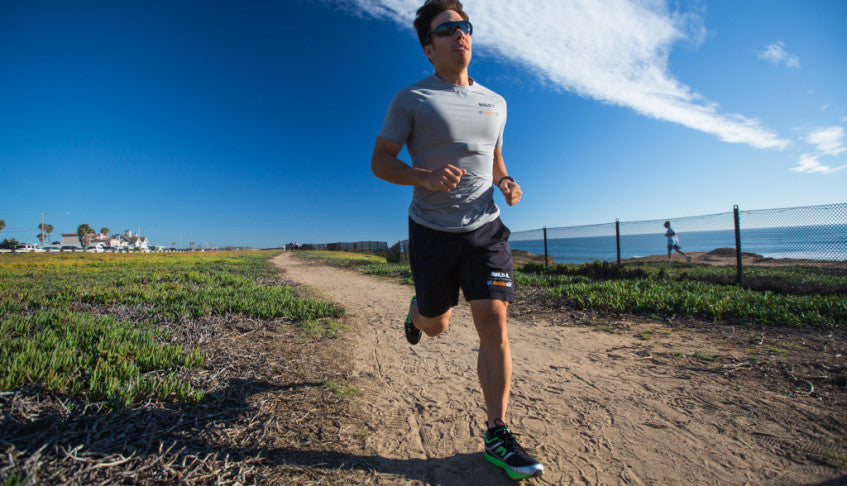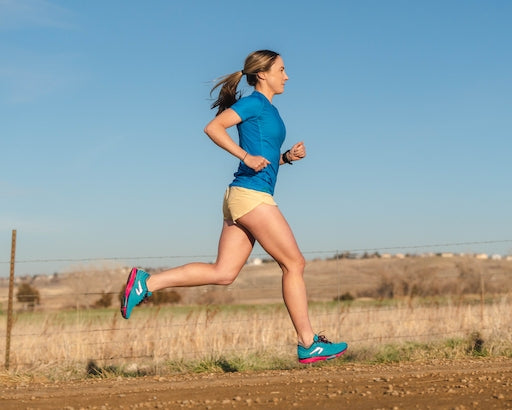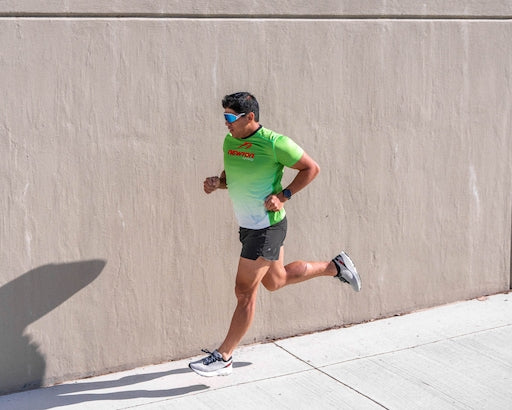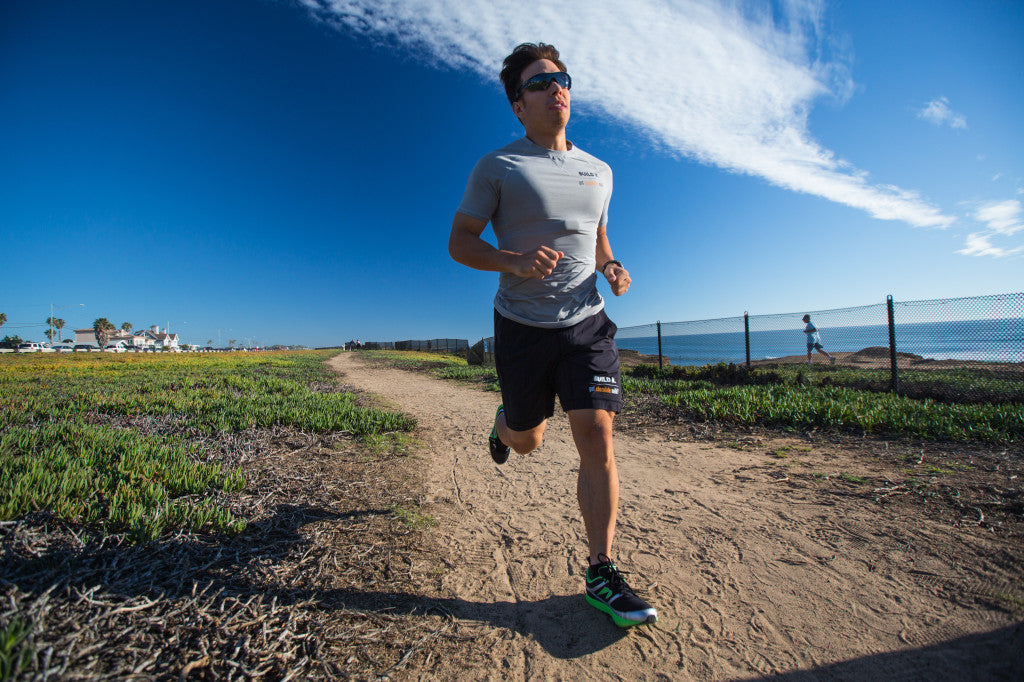
Q&A with Apolo Ohno
newton running athletes uncategorized8 October 2014
You know him as a world-class athlete and eight-time Olympic medalist and speedskater (and possibly even from Dancing with the Stars), what about as a triathlete? Only Kona will tell.
You know his face: brown eyes, the soul patch and signature wavy hair with the bandana tied around his head. Apolo Ohno is a global icon and athlete on the ice and is an internationally known face of short-track speedskating. In 2010, after making sports history by becoming the most decorated U.S. Winter Olympian of all-time, Ohno hung up his competitive skates.
Retirement doesn’t always come easy to such high caliber athletes—Ohno likes to and needs to be busy and always learning or pushing himself. By the time he retired he already had his hand in many businesses, not to mention he was a brand in his own right traveling the world regularly for speaking engagements. “I live for that pumped state of learning,” says Ohno. So naturally when the opportunity arose to train for the IRONMAN World Championship in Kona, he jumped at it. And, unlike most of us who train and then maybe try a sprint or Olympic distance triathlon first, Ohno chose the IRONMAN 70.3 Boise (half the distance of Kona) to be his first triathlon ever. Finishing in 4.57, he has only done one sprint triathlon since then.
With Kona just days away on October 11, we caught up with Ohno at his home in Los Angeles.
1. We know that you ran the New York Marathon in 2011 in a time of 3:25. What was your experience with cycling and swimming before training for Kona?
Okay, first of all, immediately after the New York marathon I stopped running. At that time I was doing a lot of weight training, kickboxing, and training with some NFL athletes out east.
For speedskating, we would bike in the summers as a team, but nowhere near the volume required for an IRONMAN. We did short bursts. And swimming, that has been nonexistent in my life since I was 12 years old.
2. We know you’re a busy guy, so what does your training routine look like?
Paula Newby-Fraser has been my rock. Paula is the queen of Kona and perhaps one of the best coaches I have ever worked with in my life. My training has been dictated by her—she puts me on a weekly schedule. Sometimes I’ll go down and train with her in Carlsbad, but mostly I train by myself because I have such a busy schedule.
Today, I have a 2.5 hour bike ride, followed by a 45 minute run off the bike. The training has cut back as we get closer to Kona. I got really sick about 11 days ago, really sick. So now we’re bringing my body back up. But it’s different every day. Yesterday I had a swim.
I needed this in my life, to re-test myself, to have a change and a challenge that is taking me out of my comfort zone and putting every element of my body to the test. It was like hitting the “reset” button on my body’s athletic memory, except with different physical challenges.
3. Have you noticed any big physical changes in your body since you’ve been training?
I haven’t lifted any weights since I’ve been training for this. I’ve leaned down. Do I look like a triathlete? I probably never will. I carry a lot of muscle mass.
4. Are there any similarities between speedskating and triathlon training and racing?
They both hurt, that’s about it. My speed-skating races lasted 40 seconds long. I trained to produce the most amount of energy in the shortest amount of time, starting from a very static, loaded position. Triathlon is a continuous non-stop aerobic activity. It was a huge change and still is a huge change.
5. What’s on your training playlist?
I like a wide variety of music—house music when I’m out for a long ride. I like to just get into a rhythm and lose track of time. A Gareth Emery podcast or Above and Beyond podcast.
6. What is the biggest thing you’ve had to wrap your head around?
The biggest thing is the fact that the training is so different. On a Saturday morning, getting up early to do a 100-mile bike ride followed by a run and being done at 1 in the afternoon. The time consumption is difficult.
And then, in Kona, what the weather will be like. Everyone says it’s beautiful, but the conditions are very hot and humid and there are 40-mile crosswinds in the bike. There are people clamoring over you in the swim and then running a full marathon after that whole day with ambient temperatures at 120-plus. How do I get through that?
7. In speedskating there is this unknown, you train and train and then in the race someone can slide into you and take you out…what is that unknown you’re worried about at Kona?
This is the most coveted endurance event on the planet. It puts your mind and physical being to the test. Everyone says there is a breaking point where you think about how you should stop and you have to push through that. There is that potential you won’t finish. I accept the challenge and I have a great team. I’ll give it my best.
8. You’ve already succeeded at the top as far as athletics go, is there anything you’ve learned from this experience that you didn’t expect?
I have been surprised at the entire triathlon community and how people welcome you with open arms. I’ve been welcomed with open arms. I had no idea how big triathlon is and how many personalities are involved in it—it’s awesome.
9. So you run in Newtons—how long have you been running in Newtons and why Newtons?
I have been wearing Newtons since I started training for triathlon. I wore traditional shoes before. As soon as I started to run more, people encouraged me to try them. When I put them on, I said, ‘Why haven’t I heard about them before?’ Newtons make sense. The Newton team established themselves as a premier running company based on performance, dynamics, and relationships with athletes. They have this cult following. They care and understand the science of running and are interested in making you run better. I plan on running in Newtons for the rest of my life.
10.You noted that you have been working with Newton athlete and coach Paula Newby-Fraser as well. How has that been?
It’s been amazing. Her ability to transfer her knowledge as an athlete to a novice like myself, and her database of knowledge is incredible. She is a great coach. She understands the body, the physiology of training, recovery, and nutrition. She has all of the elements locked in. She could coach any sport – she is that good and that smart!
11.What’s the most valuable advice she’s passed on to you?
Adapt, adapt adapt—whatever the situation is always know you have to adapt and make small adjustments along the way.
12.What advice do you have for others who are considering doing a triathlon, an IRONMAN or otherwise?
I think nutrition is a huge part of it and consistency of training. You can’t make up training if you miss it, you can’t just jump back in and be back where you were, you have to put in the time. There is time on your feet, on the saddle, and in the pool, and you can’t replace that.
It has been hard and eye opening. A lot of people who do this sport have normal lives. There is only a small amount of athletes that just train. I have a whole lot of respect for the people who do this who have kids and families and work, that’s the thing that is inspirational about triathlon, and to see how much they dedicate to the sport. It’s cool.
13.When it’s done will you hang up the bike and your swim trunks or keep going?
I don’t think I’ll just hang it up right away, I’ll continue to do some training. I really enjoy the IRONMAN triathlon world—I like being a part of it. I don’t see myself going away, but I will definitely look for new challenges.




